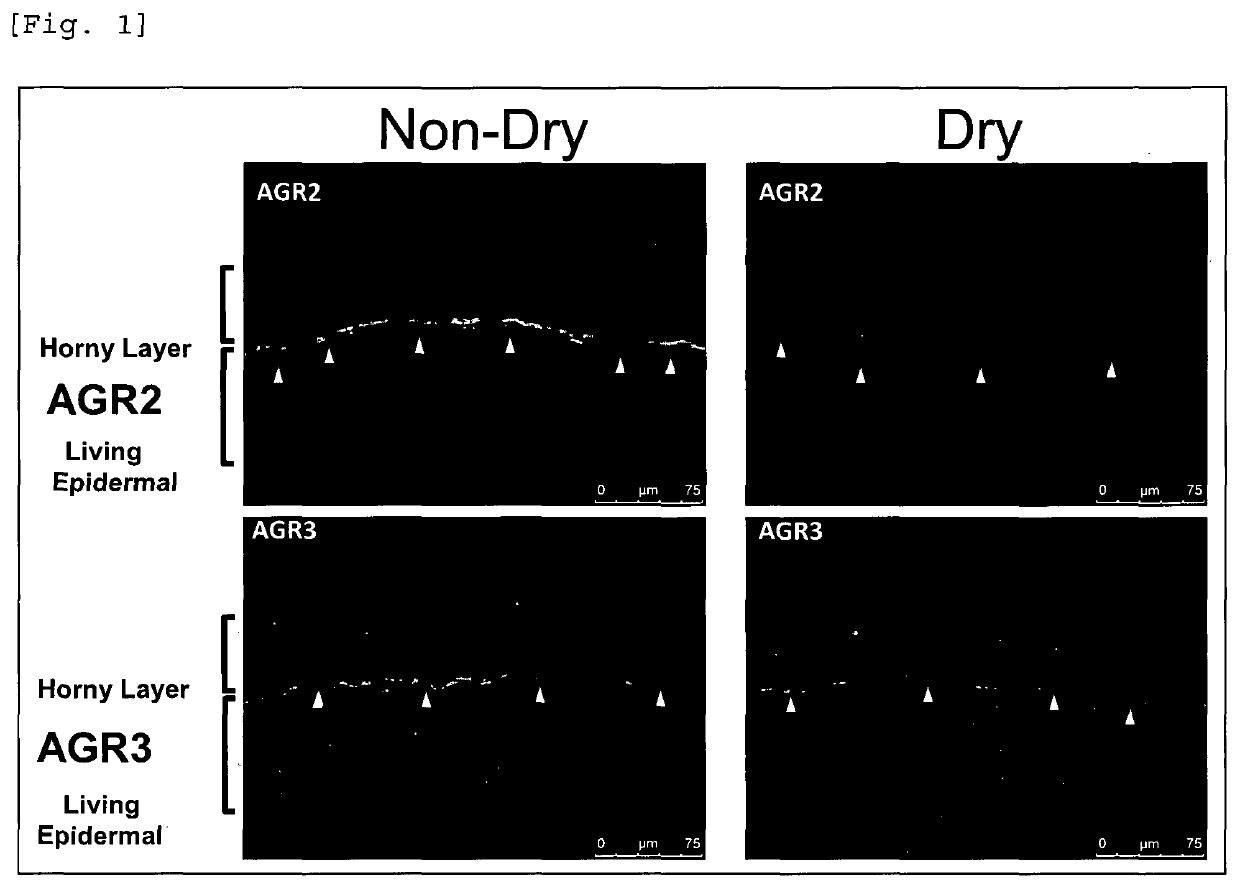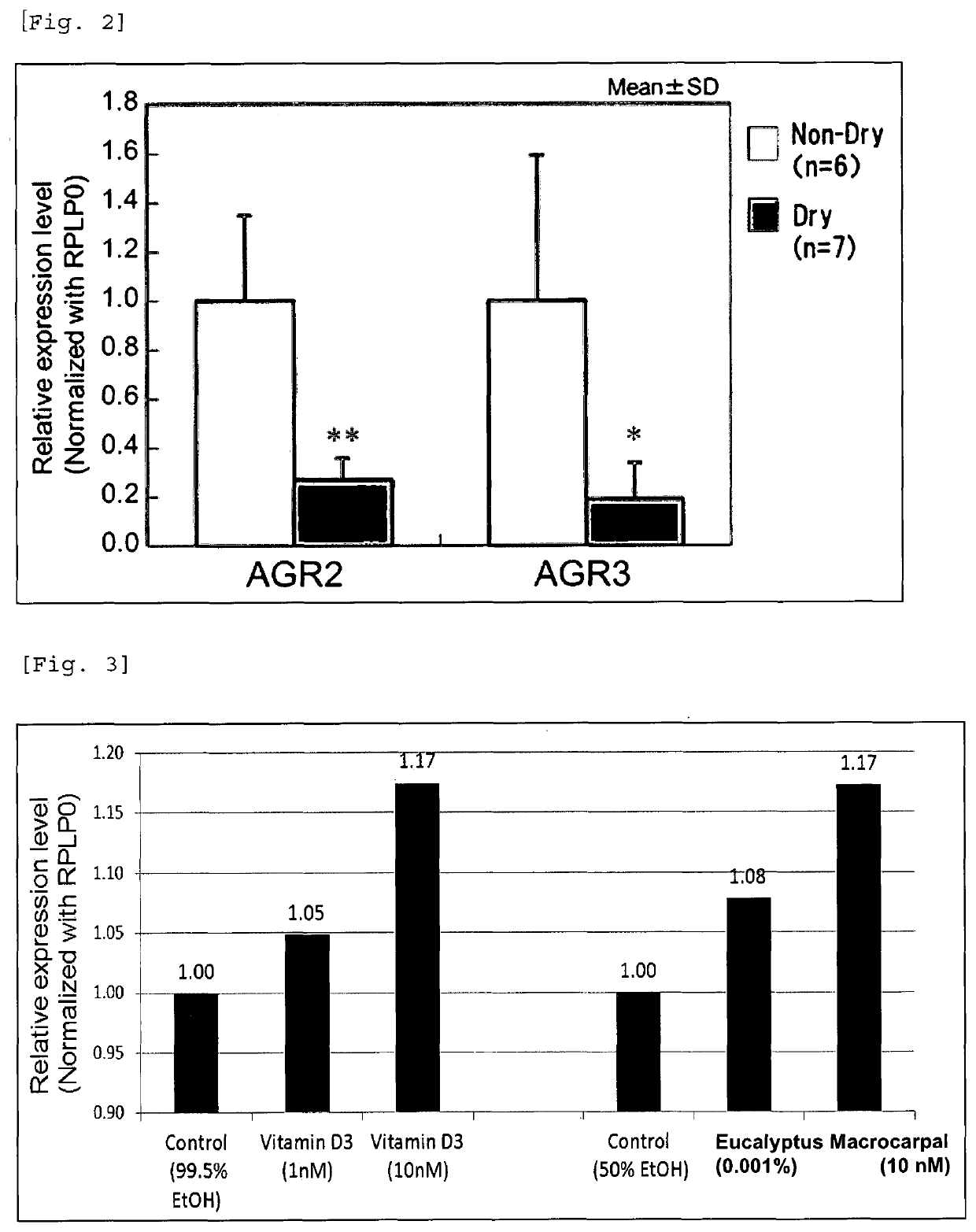Method for evaluating condition of skin dryness
a skin dryness and condition technology, applied in the field of skin dryness condition evaluation, can solve the problems of rough skin and worsening skin condition, and achieve the effect of increasing expression levels
- Summary
- Abstract
- Description
- Claims
- Application Information
AI Technical Summary
Benefits of technology
Problems solved by technology
Method used
Image
Examples
example 1
Comparison of Expression Patterns of AGR2 and AGR3 in Skin Tissue
[0104]The skin tissue collected as a sample was embedded in OCT compound (Sakura Tissue Tek) and frozen. After this, a section with a thickness of 7 μm was made with a cryotome, and the tissue section was fixed with cold acetone. After this, non-specific binding was inhibited with Protein Block Serum-Free Ready to Use (Dako). Primary antigen: Anti-AGR2 (abcam) or Anti-AGR3 (abcam) was diluted in Can get signal solution (TOYOBO) and incubated for an hour. After this, secondary antigen: Alexa555 anti-Rabbit (Life Technologies) and Alexa555 anti-Mouse (Life Technologies) were diluted in Can get signal solution and incubated for 30 minutes for visualization.
[0105]The results are shown in FIG. 1. AGR2 and AGR3 were localized and expressed on the upper part of living epidermal cell region of skin. Although the localized regions of AGR2 and AGR3 were not different between healthy people and people with dry skin, the expressio...
example 2
Comparison of Expression Levels of AGR2 and AGR3 in Skin Tissue
[0106]The skin tissue collected as a sample (7 people with dry skin and 6 healthy people) was soaked in Dispase solution, and separated into the epidermis and derma. The obtained epidermal tissue was soaked in RNA later (QIAGEN) and stored at −80° C. until used. After this, total RNA was extracted using RNeasy (Registered Trademark) Mini Kit (QIAGEN). The concentration of total RNA was measured and a reverse transcription reaction was carried out using a constant amount of total RNA. High capacity RNA-to-cDNA kit (Applied Biosystems) was used for the reverse transcription reaction. The expression of AGR2 and AGR3 mRNA was quantitatively determined from the obtained cDNA by Real-Time PCR. Taqman (Registered Trademark) Probes (AGR2: Hs00180702_m1, AGR3: Hs00411286_m1, Applied Biosystems) were used for quantitative determination, and PRISM 7500 (Applied Biosystems) was used for detection and quantitative determination. PCR ...
example 3
Correlation Between Expression Levels of AGR2 and AGR3 and Degrees of Skin Dryness
[0108]The skin dryness score and horny layer conductance in subjects (13 people) were examined. As the skin dryness score, the dry condition of a target site was visually evaluated by two examiners using 5 levels (0: no dryness, 1: slight flaking is observed, 2: moderate flaking and / or scaling are observed, 3: marked scaling and / or slight fissuring are observed, and 4: severe scaling and / or fissuring are observed), and the mean value was acquired. The horny layer conductance was measured by Skicon200EX (IBS Inc.). The skin tissue on the leg site was collected from each subject using punch biopsy. By the same procedure as in Example 2, the epidermal tissue was separated from the collected skin tissue, total RNA was extracted, the mRNA expression levels were quantitatively determined by RT-PCR, the measured value was normalized with the RPLP0 expression level, and each expression level of AGR2 and AGR3 w...
PUM
| Property | Measurement | Unit |
|---|---|---|
| temperature | aaaaa | aaaaa |
| thickness | aaaaa | aaaaa |
| softness | aaaaa | aaaaa |
Abstract
Description
Claims
Application Information
 Login to View More
Login to View More - R&D
- Intellectual Property
- Life Sciences
- Materials
- Tech Scout
- Unparalleled Data Quality
- Higher Quality Content
- 60% Fewer Hallucinations
Browse by: Latest US Patents, China's latest patents, Technical Efficacy Thesaurus, Application Domain, Technology Topic, Popular Technical Reports.
© 2025 PatSnap. All rights reserved.Legal|Privacy policy|Modern Slavery Act Transparency Statement|Sitemap|About US| Contact US: help@patsnap.com


